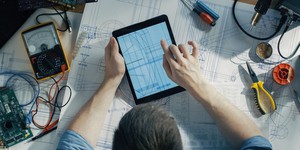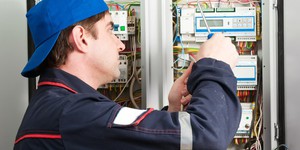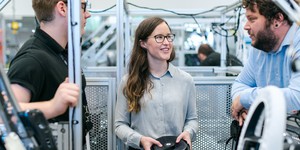Log In
Summary
*Note:
For this science project you will need to develop your own experimental procedure. Use the information in the summary tab as a starting place. If you would like to discuss your ideas or need help troubleshooting, use the Ask An Expert forum. Our Experts won't do the work for you, but they will make suggestions and offer guidance if you come to them with specific questions.
If you want a Project Idea with full instructions, please pick one without an asterisk (*) at the end of the title.
If you want a Project Idea with full instructions, please pick one without an asterisk (*) at the end of the title.
Abstract
Maybe somewhere in your home there's a long hallway or a stairway with a light that you can turn on from either end. It's a nice convenience, but did you ever wonder how it's wired up to work that way? The goal of this project is to build a similar circuit with switches, flashlight batteries and a flashlight bulb (obviously, household circuits are not safe to experiment with). You'll need to understand the difference between connections made in series and connections made in parallel in an electric circuit. For materials, you'll need 2 SPDT (single-pole, double throw) switches, a flashlight bulb, a bulb holder, 3 or 4 D-cell batteries and some insulated connecting wires with alligator clips. You can connect multiple D-cells together by laying them sideways and taping them end-to-end (with the + pole of one battery touching the − pole of the next, just like in a flashlight). Tape paper clips to the + pole of the top battery and the − pole of the bottom battery so you can connect them to your circuit. (Rosner, 2000)Bibliography
Rosner, M.A., 2000. Scientific American Great Science Fair Projects. New York, NY: John Wiley and Sons.Ask an Expert
Do you have specific questions about your science project? Our team of volunteer scientists can help. Our Experts won't do the work for you, but they will make suggestions, offer guidance, and help you troubleshoot.
Global Connections
The United Nations Sustainable Development Goals (UNSDGs) are a blueprint to achieve a better and more sustainable future for all.
This project explores topics key to Industry, Innovation and Infrastructure: Build resilient infrastructure, promote sustainable industrialization and foster innovation.
Careers
If you like this project, you might enjoy exploring these related careers:
Career Profile
Just as a potter forms clay, or a steel worker molds molten steel, electrical and electronics engineers gather and shape electricity and use it to make products that transmit power or transmit information. Electrical and electronics engineers may specialize in one of the millions of products that make or use electricity, like cell phones, electric motors, microwaves, medical instruments, airline navigation system, or handheld games.
Read more
Career Profile
Electricians are the people who bring electricity to our homes, schools, businesses, public spaces, and streets—lighting up our world, keeping the indoor temperature comfortable, and powering TVs, computers, and all sorts of machines that make life better. Electricians install and maintain the wiring and equipment that carries electricity, and they also fix electrical machines.
Read more
Career Profile
Electrical engineering technicians help design, test, and manufacture electrical and electronic equipment. These people are part of the team of engineers and research scientists that keep our high-tech world going and moving forward.
Read more
Related Links
- Science Fair Project Guide
- Other Ideas Like This
- Electricity & Electronics Project Ideas
- My Favorites
Cite This Page
General citation information is provided here. Be sure to check the formatting, including capitalization, for the method you are using and update your citation, as needed.MLA Style
Science Buddies Staff.
"Upstairs, Downstairs: Turning on a Light from Two Places." Science Buddies,
20 Nov. 2020,
https://www.sciencebuddies.org/science-fair-projects/project-ideas/Elec_p045/electricity-electronics/turning-on-a-light-from-two-places?class=AQVmyFBcNPRPu1g8NAxH2-Qd-MgrnLuTIq0IHj-T5QGCOi6gVkJNOvJV6tth2ZdhxVyWQo21S03CdKDgBqQUDt1wRh_pJWpPwq8Lawe9LwUi8w.
Accessed 26 Apr. 2024.
APA Style
Science Buddies Staff.
(2020, November 20).
Upstairs, Downstairs: Turning on a Light from Two Places.
Retrieved from
https://www.sciencebuddies.org/science-fair-projects/project-ideas/Elec_p045/electricity-electronics/turning-on-a-light-from-two-places?class=AQVmyFBcNPRPu1g8NAxH2-Qd-MgrnLuTIq0IHj-T5QGCOi6gVkJNOvJV6tth2ZdhxVyWQo21S03CdKDgBqQUDt1wRh_pJWpPwq8Lawe9LwUi8w
Last edit date: 2020-11-20
Explore Our Science Videos
Walking Water Experiment | STEM Activity
Hydroponics in a 2-Liter Soda Bottle – STEM activity.
How to Make Edible Rice Paper










